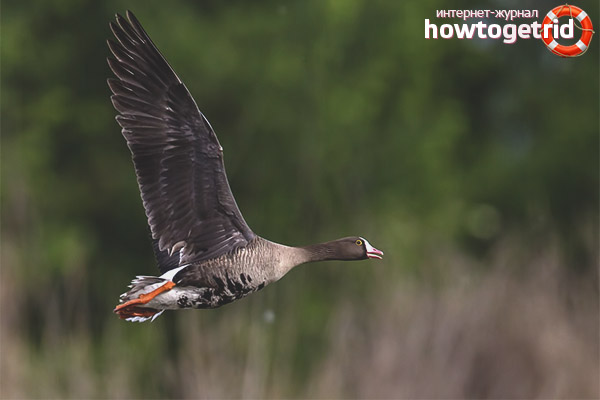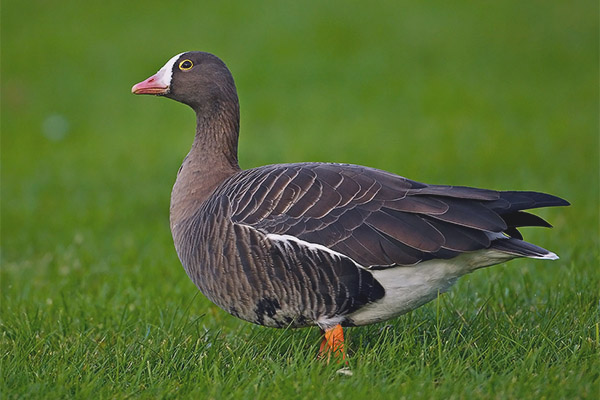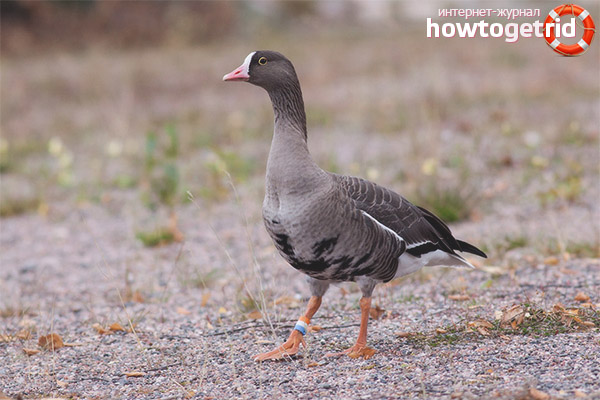The content of the article
In the family of ducks, there is a very rare and almost unexplored goose - sibling. This is a small bird, which owes its name to the peep published during the flight, which cannot be compared with anything.
Also, the bird is called white-breasted goose. And sometimes it is confused with the white-fronted goose, whose exact copy it is. An adult can reach the size of a goose, and the weight of a male is about 2.5 kg. Currently, the number of piskuleks has decreased markedly, so now this species of birds is listed in the Red Book.
Birds and Habitat Features
The length of the body of an adult male reaches 65-72 cm, and the wingspan is slightly more than a meter. The average bird weight is about 2-2.4 kg. The color of plumage of Piscula is extremely reminiscent of ordinary geese, which are bred at home: brownish and gray shades, mixed with each other.
A characteristic feature of a goose of a squirrel is its dark beak and yellowish paws. According to the shade of plumage there is no possibility to distinguish between a female and a male. A sign of sex difference is the neck of these geese, which is about 35 percent shorter in the female than in the male. From below the plumage of these birds is lighter, and there is much more fluff in the lower part of the body. Externally, squirrel is very similar to the white-fronted goose. The only difference in size is often less white-faced. In addition, there is a yellowish rim around the eyes of the piskulka, and on the forehead there is a characteristic white spot that extends to the crown itself.
Most often, Pyskulka inhabits terrain with mountainous or semi-mountainous relief. Bird nests are located in places near small streams, rivers or small lakes. They feel maximum comfort in the taiga, forest-tundra terrain or on a landscape with large shrubs, in estuaries and remote places near swamps.
You can meet Piskolku in the north of Eurasia, where it borders on the tundra, as well as in Anadyr, on the Kola and Scandinavian p / o. This species of birds is considered migratory. The wintering of the weasel is taking place on the Black Sea coast, near the Caspian Sea, in Greece, China, Hungary, Azerbaijan or Romania.
Most often, the eerie beetle erects nests near various reservoirs, but for the nesting itself a dry piece of land on small elevations is necessary. Sometimes the nests of these birds can be seen in the reeds or reed algae - this is a small dimple, lined with reed stem or cannon.
The behavior of the squirrel and its lifestyle
This goose is extremely cautious and suspicious, especially while in his pack. But all the prudence of the bird disappears at the moment when females watch the offspring or hatch eggs. In such cases, the starter may accidentally admit to the nest very close.
Representatives of this species of birds fly very fast, but for an outside observer their flight usually seems to be rather slow. In the process of the flight to warmer places, the Piskulka fly high enough.
The flight takes place in the form of a V-shaped wedge or a long wavy line. The squirrel moves on the ground in a rather firm and firm gait. Also these birds are able to run fast enough and quickly.
Often, you can see piskulku, which stands on one of the legs.Such a goose is a flock of birds, but when they breed, they are with their pair in a separate nesting place.
What eat piskulki
Any birds that belong to the Anseriformes can eat both plants and animal products. It is such a diverse diet that allows them to live and develop as fully as possible.
In spite of the fact that the starfish adores water procedures and bathing, it nevertheless belongs to the land bird species. In accordance with this, its diet consists mostly of what grows on the earth's surface.
A common food of pyskulka is green spring grass, which this season is distinguished not only by its richness, but also by the richness of mineral-vitamin compounds that any animals need after the winter has ended.
Pikulka likes to eat leaflets and stalks from young shrubs and trees no less strongly. If a flock of birds lives in a place where the fields of various cultures are located nearby, then the squirrel often begins to visit them, preferring to feast on cultivated plants.
Among the many herbs, these geese love wheat, oats, sedges, alfalfa. In the summer, squirrelle does not neglect fruit; it adores mulberry and horsetail. For the most part, this bird takes food in the morning and evening, spending the day on the water.
Breeding

During the mating season, the male Piscule is required to conquer and subdue the female. In the opposite situation, the pair is simply not formed. The family occurs only after compliance with all rules of marriage games.
An adult goose needs a variety of methods to attract the attention of the goose, which came to his taste. And if the male managed to achieve the fact that the female turned her eyes on him, then the pair is finally formed. Goose consents to the marriage.
Later, the male and female begin to engage in the arrangement of the nest, jointly creating a small fossa, which they then cover with moss, down and stalks of plants. When a nest is formed, the goose can begin laying and hatching eggs.
It takes about 27 days for the goose to hatch. Subsequently, the offspring appears, and both parents are engaged in its upbringing. The goose and goose give up all their strength to save the life of valuable offspring.
In addition, both parents teach them all the necessary knowledge. Nestlings grow and develop rather quickly, acquiring full independence, ability to fly and get food, by the age of three months.
A year later, the chicks become adults, becoming able to also have offspring. But at the same time they prefer to be close to their parents. In natural conditions, they live for about 12 years, and at home, life can be up to 30 years.
Video: squirrel (Anser erythropus)












To send